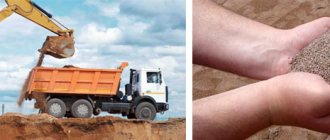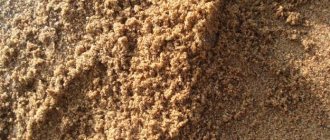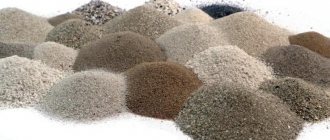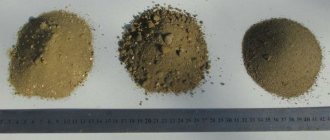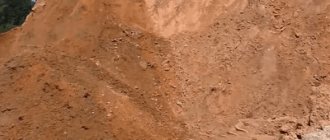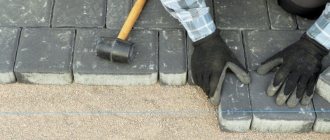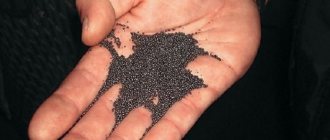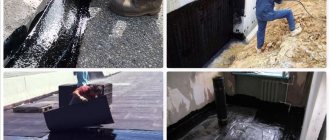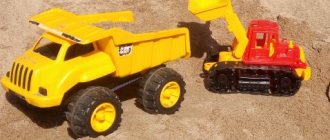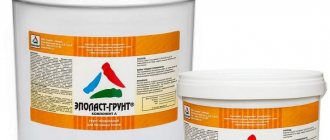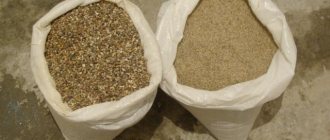Type of floor screed made of coarse sand:
Quarry sand: +7-495-997-90-97, +7-906-771-37-27
Natural natural sand is a loose rock containing grains of feldspars, mica, quartz and other natural minerals. In fact, any sand is suitable for construction.
Both river and sea or quarry are used, but the use of quarry is in demand due to its low price and good natural properties.
On this page we will look at the types of sand used for constructing concrete screeds, the characteristics of sand, particle size modules, and the price of sand in Moscow and the Moscow region.
Advantages of quartz sand for self-leveling floors
When producing polymer floors, quartz sand is one of the best options, and here's why:
- Quartz sand does not deform;
- Material consumption is much less compared to others;
- This is an environmentally friendly option that meets the standards.
Adding quartz sand to a polymer floor increases strength and makes it more beautiful and pleasant. The result of the work will be a beautiful smooth floor that will fulfill the desire of any customer both in residential premises and in public places and warehouses.
Did you find this article helpful? Please share it on social networks: Don't forget to bookmark the Nedvio website. Useful articles and tips on construction, renovation, real estate every day!
Types of quarry sand:
According to the type of processing used after extraction, sand is divided into:
Alluvial (washed) - this type of quarry sand is extracted from watered deposits and deposits in quarries using hydromechanical equipment. Thanks to the use of this technology, the sand ultimately turns out clean, that is, without impurities and unnecessary components. During mining using hydromechanical devices, clay and dust particles are washed out of the sand. The use of alluvial sand is considered the most appropriate for the production of concrete and bricks, as well as in the construction of premises, in the installation of mechanized floor screed, roads and reinforced concrete products.
Screened sand is obtained as a result of simple technical and mechanical sifting of large particles and stones. This sand is perfect for forming plaster, preparing mortar for masonry or casting foundations.
Sandy soil is an unrefined mixture of quarry sand with various components. The price for such sand is minimal, and the scope of use is, as a rule, limited to backfilling trenches or leveling the relief of a land plot.
The extraction method is the main characteristic of this bulk material.
The career type is in greatest demand, as it is more affordable in price and versatile. More information about sand subtypes:
Seeded sand.
The source material is mined in open quarries, after which it is divided into fractions by sifting through special sieves with different mesh sizes. During the sifting process, all large inclusions that do not correspond to the fractional sizes are removed from the bulk material. It makes sense to buy sand with delivery in this category for work where the chemical purity of the material and the presence of clay impurities in it are not important, namely: for the arrangement of foundations and drainage systems, plastering and facing works, road construction, the production of asphalt concrete and reinforced concrete mortars, landscaping plots.
Washed quarry sand
undergoes additional processing: the raw material is “pierced” by a high-pressure water jet. At the same time, the uniformity of the granular material becomes smoother, clay and unnecessary impurities are washed out to a high degree - that is, the quality of the sand increases significantly. However, this treatment makes sand significantly more expensive, and it is usually purchased for more delicate work. In particular, for laying bricks and cinder blocks, since a solution based on washed sand settles to a much lesser extent than when using seeded sand. An equally important area of application for washed sand is the production of bricks and paving slabs, in which the quality of the resulting product is greatly affected by the presence of clay inclusions.
river sand
the price exceeds even alluvial quarry material, since it is initially an extremely pure material with a fine fraction and ideally low radioactivity. It is used much less frequently than any quarry type, since it unjustifiably inflates the final cost of construction. It is used only in cases where completely clean bulk material is required. River sand is especially valuable for the construction of complex drainages: it has a very high filtration coefficient, that is, the ability to pass water through its layer. It is also used in the production of high-quality bricks: the characteristics of sand in all respects correspond to the first class and are characterized by very high environmental friendliness.
Production of quartz sand for self-leveling floors
To create a self-leveling floor, you will need high-quality sand, which must be made using a special technology and not contain impurities. The production of quartz sand for self-leveling floors is a complex and lengthy process that requires high technical equipment of plants. This is why the cost of quartz sand increases, but compared to polymers, such sand will be cheaper.
Characteristics and properties of sand
The main property of quarry sand is its purity and absence of impurities. Moreover, alluvial quarry material has the following characteristics:
- Fractions vary from 1.5 to 5 mm.
- Low percentage of dust, clay and other impurities - no more than 0.03%.
- The density of alluvial quarry sand is 1.60 g/cm3.
Depending on what fraction the sand grain has, the alluvial material is divided into the following categories: small, large fraction and medium-sized fraction. The shades of quarry sand also differ and can be either amber-yellow or brown, depending on the deposits and the quarry.
Construction sand size modules
This indicator reflects the size of sand fractions and includes the following varieties:
silty. This type of sand has a very fine structure, resembling dust in appearance. The grain size of this material ranges from 0.05 to 0.14 mm. In turn, silty sands are usually divided into several subtypes: unimportant, wet and saturated with water.
- fine sand, the grain size of which is from 1.5 to 2.0 mm.
- medium-sized, which includes fractions from 2 to 2.5 mm.
- large, having grains of 2.5 - 3.0 mm, which we use for semi-dry floor screed.
- increased fineness - from 3.0 to 3.5 mm.
- very large, having grains measuring 3.5 mm or more.
According to the type of processing used after extraction, sand is divided into:
Alluvial (washed) - this type of quarry sand is extracted from watered deposits and deposits in quarries using hydromechanical equipment. Thanks to the use of this technology, the sand ultimately turns out clean, that is, without impurities and unnecessary components. During mining using hydromechanical devices, clay and dust particles are washed out of the sand. The use of alluvial sand is considered the most appropriate for the production of concrete and bricks, as well as in the construction of buildings, roads and reinforced concrete products.
Screened sand is obtained as a result of simple technical and mechanical sifting of large particles and stones. This sand is perfect for forming plaster, preparing mortar for masonry or casting foundations.
Sandy soil is an unrefined mixture of quarry sand with various components.
The price for such sand is minimal, and the scope of use is, as a rule, limited to backfilling trenches or leveling the relief of a land plot. Varieties of river sand
Based on the size of individual particles, river sand is divided into:
- fine (particles up to 2mm);
- medium (particles from 2.0 to 2.8 mm);
- large (particles from 2.9 to 5 mm).
How to get sand
The production of sand material is associated with various natural “niches”:
- Coast;
- geological quarries where marble, granite, and clay are produced (sand accompanies them);
- a purely “sand” quarry in places where sand massifs occur;
- ravines;
- river coastal zones.
During extraction, the original raw material contains a lot of unnecessary impurities, as well as different grain sizes.
To remove impurities, the extracted natural material is washed with water (“alluvial” sand). To sort by size, sift. The output is fractionated sand. Each fraction has a certain grain size in accordance with approved GOST standards. Naturally, fractionated sand is much preferable for floor screeding, because you can use different calibers when installing floors of different types of use.
The difference between quarry sand and river sand
According to GOST, river and quarry sand are not separated.
The whole difference between these two breeds is the price, which for river breeds is several times higher than for quarry breeds. If we compare the compositions of two types of sand, then river sand is pure, without impurities and third-party elements, while quarry sand contains clay (which is sometimes very useful). Therefore, it is impossible to say unequivocally which is better: quarry sand or river sand. River sand:
It is believed that this is the highest quality filler for concrete mortar, the strength of which is especially important when constructing load-bearing structures. The advantages of the material, as a rule, include the following features.
- It does not contain clay and silt particles, which are unacceptable in cement-sand mortars and deteriorate their quality.
- The oval-shaped crystals do not become compacted during the preparation of the concrete mixture, the cement laitance evenly envelops them, and the finished concrete practically does not shrink.
The disadvantages of river sand include:
- Mixing with river sand requires more cement and more thorough mixing.
- This is the most expensive of construction sands.
Quarry sand:
Despite the fact that quarry sand is inferior in quality to river sand, it is in demand in the construction industry and has a number of advantages.
- Much more common.
- Less cement is used to prepare concrete - this is due to the property of irregularly shaped crystals to compact more strongly.
- It has an attractive price.
- The enriched product meets the highest standards.
Among the disadvantages of quarry sand, experienced builders note the following.
- Quarry sand contains a higher percentage of organic clay and silty particles - up to 7% versus 0.05% in its river counterpart.
- Due to its structural composition, it settles and becomes compacted at the moment the concrete sets and hardens.
So, quarry sand is a versatile and also popular construction material that is used in many fields of activity. It has an exceptionally low cost due to its simple extraction process and lack of processing.
Types of sand for screed
Cement screed ensures a smooth floor covering. To prepare a high-quality solution, the following types of construction sand are used:
- Career. Such sand in its original form contains up to ten percent of various impurities. Most often, it contains clay, which is completely unsuitable for the base of the floor covering. Therefore, only purified sand is used to make the solution. It undergoes special cleaning with water right in the quarries. The result is pure high-quality material without minor additives.
- River. Sand extracted from the bottom of a reservoir does not contain clay, but various stones may be present. When preparing a solution for screed from such a material, it should be stirred regularly. This is due to the fact that river sand has the ability to settle to the bottom. Often, to improve its characteristics, purified bulk material extracted from quarries is added to it.
- Nautical. This natural material is not much different from river sand. Its cost is much higher than the quarry one. This is due to the high costs of extracting sand from the seabed. The material turns out to be completely pure and practically homogeneous, with good technical characteristics. Screeds with the addition of sea sand have increased strength.
- Artificial. Mortar for pouring floors is often made from quartz sand. The material is completely clean and has high strength, which can significantly increase the quality of the floor screed. It is obtained by crushing quartz rocks. In the construction industry, artificial sand is in great demand.
Requirements for sand for semi-dry floor screed
1. Construction sand used for screeding should not contain additional impurities in the form of organic matter, clay, lime and solid particles larger than 5 mm in size. The maximum permissible presence of impurities should not exceed 5% of the total volume. It should be understood that the presence of the maximum permissible amount of impurities sharply reduces the quality of the cement mixture used for semi-dry screed.
2. In practice, sand with an impurity content of more than 1.5% is no longer used for floor screed work. This situation limits the use of quarry sand, unless it has been thoroughly washed using special equipment. Most types of sand of artificial origin can be used for screeding, but its high cost limits the use of such material for construction work. Artificial sands are used mainly in industrial production for technological purposes.
3. In order to check the quality of sand without going to the laboratory, you need to collect the material in a transparent container, filling it one third. After this, pour another third of water into it and mix well. If after 5-7 minutes the water becomes relatively transparent and there is no foreign debris in it, then the sand can be used for work. Otherwise, the material is considered dirty and is not suitable for screeding.
Requirements for the quality of sand for concrete screed in different types of premises
The unanimous opinion of experienced builders: the best sand option for concrete screed is pure river material containing a minimum amount of impurities. In real conditions, not every region of Russia has the opportunity to quickly and inexpensively supply the required raw materials to the site. The main requirement for the quality of a screed is its resistance to possible loads. This factor largely depends on the intended purpose of the future object. For buildings and structures with high floor strength requirements, it is worth using exclusively material washed in the river. If the premises are intended for industrial use, where vibration and surface impacts are possible, additional reinforcement cannot be avoided.
The preparation of screed for objects intended for residential use allows the use of mountain sand with the presence of impurities and organic substances. This is due to lower requirements for floor strength. In this case, higher demands are placed on the correct choice of cement marking and screed option. The quality characteristics of the sand do not play such a role here, since a floor covering will be laid on the concrete, which is an additional protection for the concrete screed.
